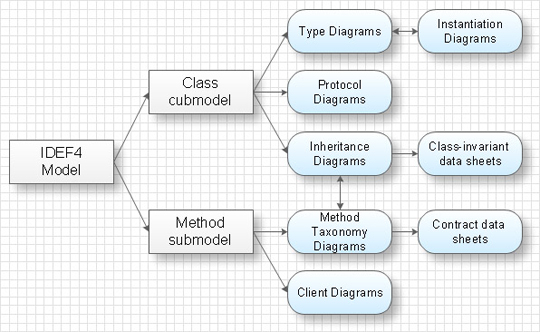"In elementary algebra, a quadratic equation (from the Latin quadratus for "square") is any equation having the form
ax^2+bx+c=0
where x represents an unknown, and a, b, and c are constants with a not equal to 0. If a = 0, then the equation is linear, not quadratic. The constants a, b, and c are called, respectively, the quadratic coefficient, the linear coefficient and the constant or free term.
Because the quadratic equation involves only one unknown, it is called "univariate". The quadratic equation only contains powers of x that are non-negative integers, and therefore it is a polynomial equation, and in particular it is a second degree polynomial equation since the greatest power is two.
Quadratic equations can be solved by a process known in American English as factoring and in other varieties of English as factorising, by completing the square, by using the quadratic formula, or by graphing." [Quadratic equation. Wikipedia]
The flowchart example "Solving quadratic equation algorithm" was created using the ConceptDraw PRO diagramming and vector drawing software extended with the Mathematics solution from the Science and Education area of ConceptDraw Solution Park.
ax^2+bx+c=0
where x represents an unknown, and a, b, and c are constants with a not equal to 0. If a = 0, then the equation is linear, not quadratic. The constants a, b, and c are called, respectively, the quadratic coefficient, the linear coefficient and the constant or free term.
Because the quadratic equation involves only one unknown, it is called "univariate". The quadratic equation only contains powers of x that are non-negative integers, and therefore it is a polynomial equation, and in particular it is a second degree polynomial equation since the greatest power is two.
Quadratic equations can be solved by a process known in American English as factoring and in other varieties of English as factorising, by completing the square, by using the quadratic formula, or by graphing." [Quadratic equation. Wikipedia]
The flowchart example "Solving quadratic equation algorithm" was created using the ConceptDraw PRO diagramming and vector drawing software extended with the Mathematics solution from the Science and Education area of ConceptDraw Solution Park.
IDEF4 Standard
Use Case Diagrams technology. IDEF4 standard implies not only graphical presentation but the additional information about diagrams of heredity, methods systematization and types which are contained in specifications.- Euclidean algorithm - Flowchart | Solving quadratic equation ...
- Invoice payment process - Flowchart | Accounting Flowchart ...
- Payment Process Flow Chart Sample
- Basic Flowchart Symbols and Meaning | Flowchart design ...
- Types of Flowchart - Overview | Process Flowchart | Accounting ...
- Flowchart Programming Project. Flowchart Examples | Euclidean ...
- Basic Audit Flowchart . Flowchart Examples | Simple Flow Chart ...
- Financial Flow Chart Examples
- Flow Diagram Software | Flowchart Program Mac | Accounting ...
- Programming Flowchart Problems And Solutions
- Basic Flowchart Symbols and Meaning | Flowchart design ...
- Sample Project Flowchart . Flowchart Examples | Process Flowchart ...
- Basic Flowchart Symbols and Meaning | Audit Flowchart Symbols ...
- Business Diagram Software | Flow chart Example . Warehouse ...
- Sample Project Flowchart . Flowchart Examples | Flowchart ...
- Software Work Flow Process in Project Management with Diagram ...
- Flow Diagram Software | Accounting Flowchart : Purchasing ...
- Top 5 Android Flow Chart Apps | Flowchart Programming Project ...
- Flowchart Symbols Accounting. Activity-based costing (ABC ...
- Process Flowchart | Simple Flow Chart | Sales Process Flowchart ...

